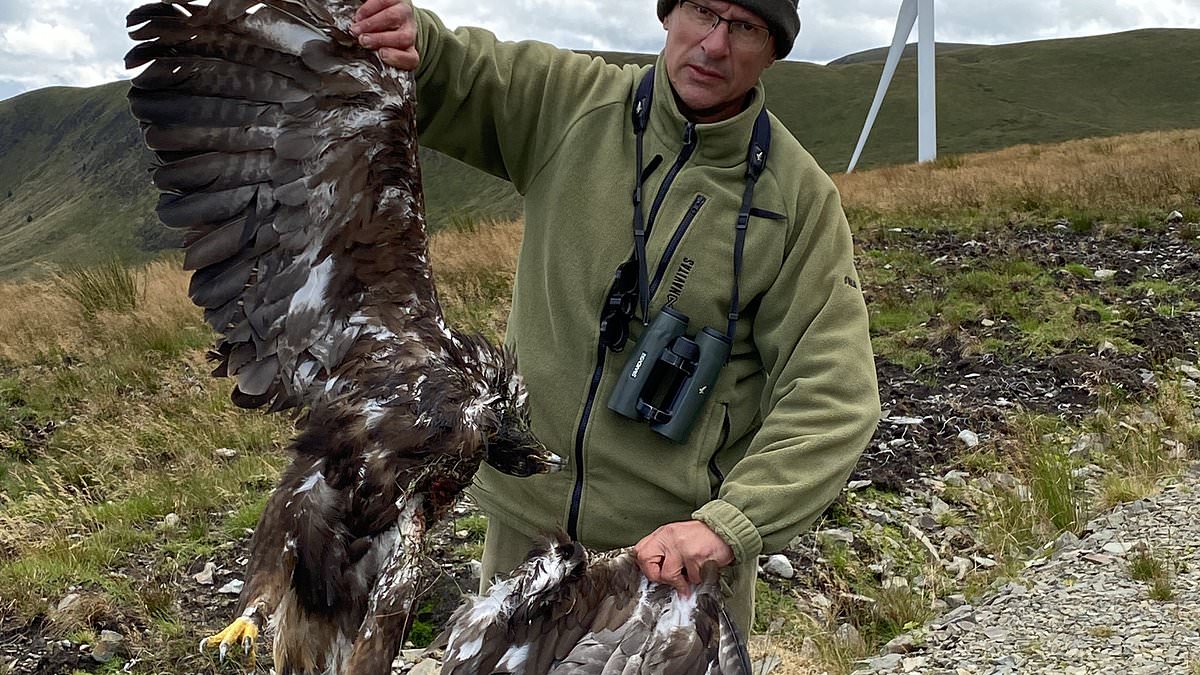A golden eagle has died after a ‘wind turbine strike’ in Dumfries and Galloway, an investigation has concluded.
The death of the locally-fledged bird, named Sparky, is the first recorded incident of its kind in the south of Scotland, according to conservation body South of Scotland Golden Eagle Project (SSGEP).
The group, which monitors and researches the golden eagle population in the area, said they learned ‘something untoward’ had happened to the three-year-old raptor on the afternoon of August 22 this year from their satellite tagging system.
They quickly found the body, which was lying 15 metres from a turbine base with its wing detached, and worked with staff at the wind farm to secure the body for pathological investigations.
After carrying out a number of tests, on Monday the Veterinary Investigation Centre at Scotland’s Rural College in Dumfries concluded Sparky’s fatal injuries were ‘typical of those associated with a wind turbine strike’.
SSGEP project manager Dr Cat Barlow said: ‘Our satellite tagging system allowed us to immediately detect that something untoward had happened to Sparky at Windy Rig wind farm in Galloway.
‘This ensured investigators could quickly recover the body before weather and wild scavengers destroyed any evidence.
‘Without our team’s surveillance and ability to respond promptly, we may never have known what led to Sparky’s death.
‘Gathering knowledge from the satellite tags is vital to ensuring the continued protection of golden eagles and further reinforces the importance of our work to monitor golden eagles in southern Scotland.’
She added: ‘Though sustainable energy is key to addressing the climate crisis and protecting our natural world in the long-term, as Sparky’s death shows, death through wind turbine collision is a risk, so it is important that charities like ours exist to support work to mitigate risks to golden eagles – both at existing sites and when new development proposals are being considered.
‘We can use our unique insights to advise decision-makers, so that developments do not harm golden eagles, habitats or their prey.
‘Through our monitoring work and technology, we are uniquely placed to do this in the south of Scotland.’
Chris Rollie, chair of the Dumfries and Galloway Raptor Study Group – after one of whose members Sparky was named – said they were ‘devastated’ to learn of Sparky’s death.
He continued: ‘Evidence to date has suggested golden eagles tend to avoid wind farms, but without the state-of-the-art satellite tagging that SSGEP provides, incidents of this nature are hard to detect.
‘This reinforces the urgent need for decision-makers to work closely with the South of Scotland Golden Eagle Project and our raptor study group as further wind farms are approved.’
Morag Watson, director of onshore at Scottish Renewables, which represents the renewable energy sector in Scotland, said: ‘All wind farms in Scotland go through years of environmental monitoring before they are built and evidence to date has suggested golden eagles tend to avoid well-sited wind farms, so it is incredibly sad to hear about this incident.
‘The renewable energy industry works closely with bodies including the Scottish Government, NatureScot, RSPB and others to better understand bird behaviour and make sure wind developments are sensitive to bird populations.
‘We look forward to working with the South of Scotland Golden Eagle Project and utilising its expertise to allow the onshore wind sector to play an important role in the protection of golden eagles in southern Scotland.’
Sparky’s death comes after that of another eagle, named Thistle, which had been translocated by SSGEP in August 2022.
Thistle was found to have been killed by another territorial eagle in what the group described as ‘normal population behaviour’.
Since it was set up in 2017, SSGEP has ‘translocated’, or introduced, more than 40 golden eagles to the area, as well as tagging a number of locally-fledged birds, and the population is now at the highest level for three centuries.
The project had been due to conclude this year, but the group, which previously received public funding from a number of sources, now plans to continue its work as a standalone charity.
